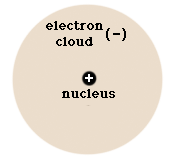PLASMA
There are three very familiar states of matter: solid, liquid, and gas. There is also a fourth state of matter known as plasma that plays an important (if understated) role in nature, especially in the process of fusion. To understand what a plasma is, it is necessary to first understand basic atomic structure.  In a neutral atom all the positive charge is held by the collection of protons in the tiny nucleus at the center of the atom. The nucleus is surrounded by a cloud of electrons that carry the opposing negative charge of the atom.
At low energies/temperatures the overall atom is securely held together by the opposite charges of the nucleus and the electron cloud.
In a neutral atom all the positive charge is held by the collection of protons in the tiny nucleus at the center of the atom. The nucleus is surrounded by a cloud of electrons that carry the opposing negative charge of the atom.
At low energies/temperatures the overall atom is securely held together by the opposite charges of the nucleus and the electron cloud.
In a sample of matter where these atoms could freely move about, the atoms would collide into each other, but the interactions would be limited to the outer electron clouds. This is because the electrostatic repulsion from the electron clouds would prevent the atoms getting any closer than a certain distance. Therefore, the nuclei of different atoms could not interact with each other.

But, as energies go up, the attraction between the nucleus and the electrons isn't strong enough to keep the electrons bound. If the temperature goes high enough, the electrons forming the electron cloud can break free from the attraction of the nucleus. When this happens the basic atomic structure is broken down. Instead of having individual atoms where each nucleus has its own electron cloud, all of the dissociated electrons blend together to form a huge "sea" or background of electrons, and the nuclei "swim" in this sea.
 Because of this, the nuclei, which were prohibited from interacting with each other because of their surrounding electron cloud, are now free to interact with each other. Since they are positively charged, they also feel an electrostatic repulsion as they approach. This results in most of their collisions being just like marbles bouncing off one another. It is not until the temperature goes even higher that collisions have enough energy to permit the strong nuclear force to hold the nuclei together, and release the energy that will make the star "shine." This plasma state must exist in order for the process of fusion to happen at all.
Because of this, the nuclei, which were prohibited from interacting with each other because of their surrounding electron cloud, are now free to interact with each other. Since they are positively charged, they also feel an electrostatic repulsion as they approach. This results in most of their collisions being just like marbles bouncing off one another. It is not until the temperature goes even higher that collisions have enough energy to permit the strong nuclear force to hold the nuclei together, and release the energy that will make the star "shine." This plasma state must exist in order for the process of fusion to happen at all.
 In a neutral atom all the positive charge is held by the collection of protons in the tiny nucleus at the center of the atom. The nucleus is surrounded by a cloud of electrons that carry the opposing negative charge of the atom.
At low energies/temperatures the overall atom is securely held together by the opposite charges of the nucleus and the electron cloud.
In a neutral atom all the positive charge is held by the collection of protons in the tiny nucleus at the center of the atom. The nucleus is surrounded by a cloud of electrons that carry the opposing negative charge of the atom.
At low energies/temperatures the overall atom is securely held together by the opposite charges of the nucleus and the electron cloud.

 Because of this, the nuclei, which were prohibited from interacting with each other because of their surrounding electron cloud, are now free to interact with each other. Since they are positively charged, they also feel an electrostatic repulsion as they approach. This results in most of their collisions being just like marbles bouncing off one another. It is not until the temperature goes even higher that collisions have enough energy to permit the
Because of this, the nuclei, which were prohibited from interacting with each other because of their surrounding electron cloud, are now free to interact with each other. Since they are positively charged, they also feel an electrostatic repulsion as they approach. This results in most of their collisions being just like marbles bouncing off one another. It is not until the temperature goes even higher that collisions have enough energy to permit the